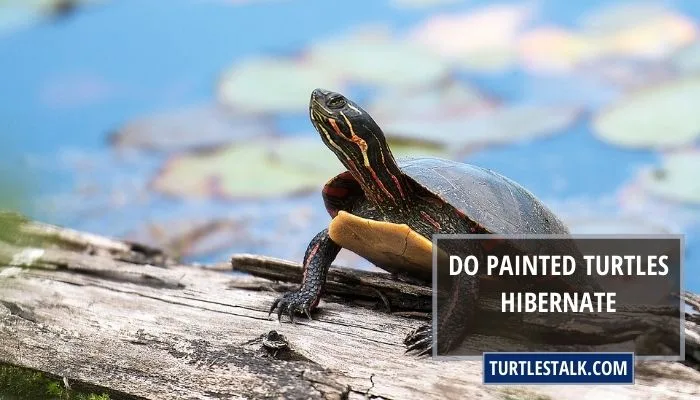Do Painted Turtles Hibernate? – Surviving The Winter
Painted turtles are a common species of turtle found throughout North America. These turtles are known for their colorful and vibrant shells. One behavior they are also known for is their ability to hibernate during winter.
Painted turtles, like many other species of turtles, enter a state of dormancy during the colder months of the year, usually called hibernation. It allows the turtles to conserve energy during the winter months when they would otherwise need to expend a great deal of energy to search for food.
As the temperatures decrease and days become shorter, the turtles will seek out a body of water with a muddy bottom, such as a lake, pond, or slow-moving river. Once the turtles find a suitable location, they will bury themselves in the mud and remain there until the temperatures become more favorable.
Why Do Painted Turtles Hibernate?
Hibernation is a survival strategy that is used by many animals, including turtles, to conserve energy during periods of food scarcity or extreme weather conditions. Like many other cold-blooded animals, painted turtles are ectothermic, meaning the environment regulates their body temperature.
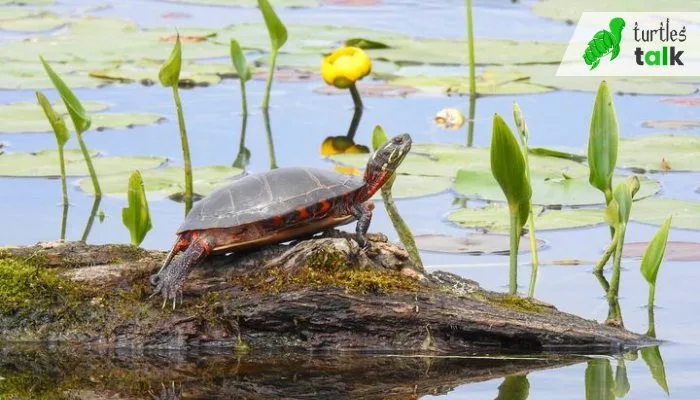
During the winter months, when the water in their habitats begins to freeze, painted turtles are unable to forage for food, and their metabolism slows down. Hibernation allows them to survive these harsh conditions by reducing their energy requirements and preserving their body’s resources.
The process of hibernation in these turtles begins in the fall, as the days grow shorter and the water temperature begins to drop. The turtles will begin to slow down their activities and stop eating, allowing their bodies to begin the process of shutting down.
As the water temperature continues to drop, the turtles will become less active, and their heart rate and breathing will slow down. Eventually, the turtles will bury themselves in the mud or sediment at the bottom of the pond or lake and enter a state of torpor.
During this state of torpor, their metabolism slows down, and they enter a dormant state. This allows them to conserve energy and survive winter without food or water. The turtles will remain in this state until the water temperature begins to rise in the spring, signaling the end of hibernation.
Hibernation and Reproduction
Hibernation also plays an important role in the reproduction of painted turtles. Male painted turtles typically emerge from hibernation earlier than females and will begin to search for mates as soon as the water temperature rises. This ensures that they are the first to mate when the females emerge from hibernation.
How to Tell if a Painted Turtle Is Hibernating?
Painted turtles are cold-blooded animals, which means their body temperature is affected by the temperature of their environment. In the wild, they will hibernate when the water temperature drops below 50 degrees Fahrenheit. In captivity, they may not hibernate if the water temperature is kept warm enough.
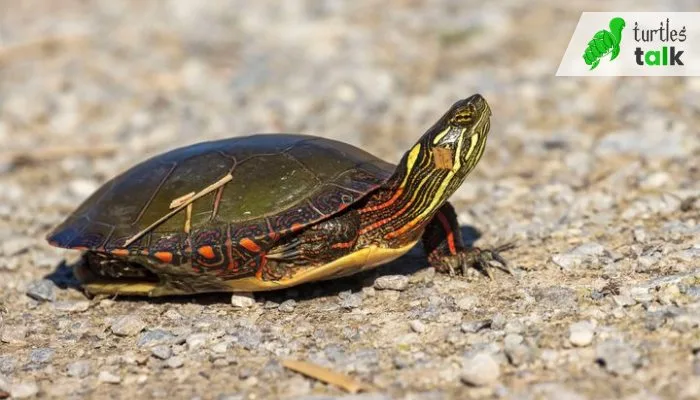
There are several signs that you can look for to determine if your painted turtle is hibernating. They include:
Reduced Activity
The most obvious sign of hibernation is a significant reduction in activity. If your turtle is usually active and responsive but suddenly becomes sluggish and unresponsive, it may be hibernating.
Decreased Appetite
During hibernation, turtles will eat less or not at all. If your turtle is not eating or showing little interest in food, it may be hibernating.
Cooler Body Temperature
Turtles will lower their body temperature during hibernation, which can be measured using a thermometer. If your turtle’s body temperature is significantly cooler than normal, it may be hibernating.
Slow Breathing
Turtles will also slow down their breathing during hibernation. If your turtle’s breathing is slow and shallow, it may be hibernating.
Mud or Sand in the Enclosure
Turtles will often bury themselves in mud or sand during hibernation. If you notice mud or sand in your turtle’s enclosure, it may be hibernating.
What Is the Best Way to Tell if a Turtle Is Dead or Hibernating?
Determining whether a turtle is dead or hibernating can be a difficult task, particularly for inexperienced turtle owners. There are, however, several telltale signs that can help distinguish between the two.
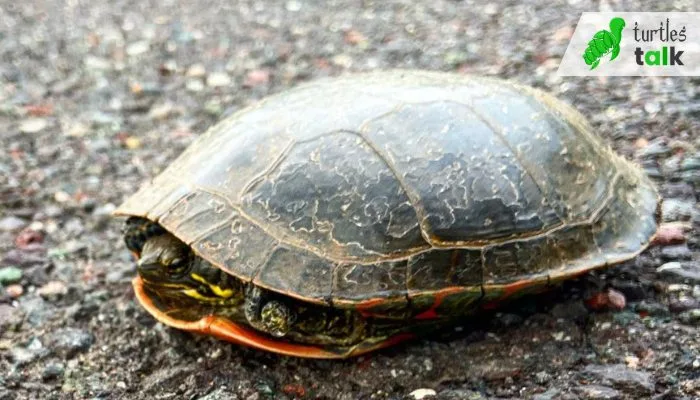
The best way to tell if a turtle is dead or hibernating is by checking for a heartbeat. If there is no heartbeat present—the turtle is officially dead. Checking the turtle’s breathing can also help assess if it is dead or hibernating. Dead turtles will not show any signs of breathing, while hibernating turtles may take shallow and infrequent breaths.
If a turtle is dead, it will typically have a rigid, lifeless body and deep sunken eyes. There will be no movement at all, even if you try to prod it gently. Other signs of hibernation include hideaway behavior—such as hiding in a corner of their tank—and closed eyes.
Hibernating turtle’s body will be soft and flexible, and it may react to touch, albeit slowly. Furthermore, the temperature of the turtle can also be a helpful indicator. If the turtle is dead, its body will be cold to the touch, while a hibernating turtle will have a body temperature similar to its environment.
What to Do if You Find a Painted Turtle Hibernating?
If you discover a painted turtle hibernating, it is important to leave the turtle undisturbed. There are a few things you should do.
Leave It Be
One of the best things you can do is leave the turtle alone. Painted turtles often hibernate for months at a time, so it can be tempting to try to help them out. But according to the Missouri Department of Conservation—it’s best not to disturb them.
Do Not Move the Turtle
Painted turtles are native to the United States and are protected under federal law. Do not move a hibernating turtle from its spot—even if it’s in your garage or yard. Painted turtles are best left in the wild—so don’t try to relocate them.
Do Not Feed Them
During hibernation, painted turtles do not eat. Feeding them during this time can be harmful—leading to weight gain and possibly death.
Provide Shelter and Food After They Wake Up
Once the turtle has emerged from its hibernation spot, you can provide shelter and food to help it recover. According to the Missouri Department of Conservation—it’s best to leave the turtle alone for about a week after it wakes up—allowing it to recover on its own.
How to Care for a Painted Turtle During Hibernation?
During the winter months, you should take extra steps to ensure your pet turtle is properly cared for during hibernation. Here is a guide to help you properly care for your painted turtle during hibernation.
Monitor your turtle’s temperature
Turtles require different temperatures at different times of the year, and during hibernation, it is important to monitor the temperature in their habitat. Ideally, the temperature should stay between 4-7°C (40-45°F) during hibernation.
Ensure Proper Humidity Levels
When preparing your turtle’s hibernation area, be sure to maintain a humid environment by frequently spraying it with water. This will help your turtle’s skin to stay moist and prevent it from drying out.
Provide Adequate Sheltering
Your turtle will spend most of its hibernation time in its hiding place, so make sure it is large enough to fit your turtle’s needs. You may also want to consider providing a hiding place with a temperature regulator—helping to regulate the temperature of your turtle’s hibernation area.
Provide a Hibernation Spot
Turtles prefer to dig a spot in cool, dry soil, but you can also provide a large plastic container filled with shredded newspaper. Put the container inside a cool, dry place like a garage, basement, or shed. Monitor the temperature and humidity of the hibernation spot and ensure it stays cool for the duration of hibernation.
Monitor for Signs of Health Problems
During the hibernation process, it is important to monitor your turtle for any signs of health problems. These may include a lack of appetite, weight loss, abnormal breathing, or abnormal coloration—ensuring that your turtle is healthy and ready for its next season.
Re-Waken Your Turtle Slowly
At the end of your turtle’s hibernation period—you may want to slowly re-awaken your turtle by gradually raising the temperature in its tank. This will help your turtle acclimate to its new environment and prepare it for its upcoming season.
Do Painted Turtles Hibernate in Captivity?
In captivity, painted turtles may or may not hibernate, depending on the conditions provided by their owner. Some painted turtles will naturally enter a state of hibernation, while others may not.
There are several factors that can affect whether a painted turtle will hibernate in captivity. These include:
Temperature
There is a certain temperature range for these turtles to enter hibernation. In the wild, they typically enter hibernation when the water temperature drops below 50 degrees Fahrenheit. In captivity, if the water temperature is kept above this range, the turtle may not enter hibernation.
Lighting
They require an optimum amount of natural light to enter hibernation. In the wild, they will enter hibernation as the days shorten and the amount of natural light decreases. In captivity, if the turtle is kept in a room with artificial light, it may not enter hibernation.
Food
They need a certain amount of food to enter hibernation. In the wild, they will eat as much as possible before entering hibernation to store energy. In captivity, if the turtle is fed regularly, it may not enter hibernation.
Where Do Painted Turtles Hibernate?
In the winter months, painted turtles will enter a state of hibernation. During this period, painted turtles will look for a suitable location to hibernate, and this varies depending on the species.
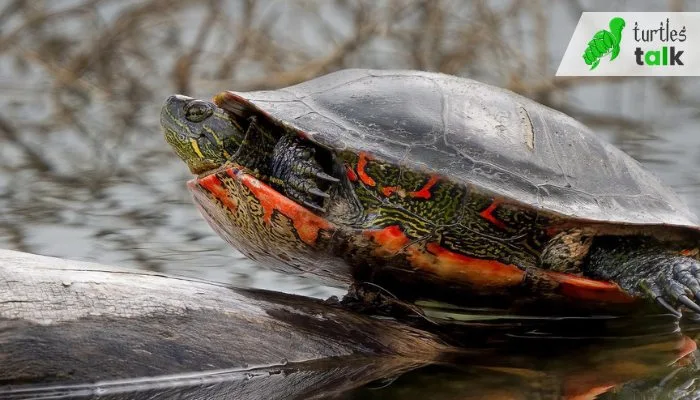
Generally, painted turtles will seek out locations that are close to the water and are sheltered from cold temperatures. This could be as shallow as a few inches of mud or as deep as several feet of water.
They also prefer a location that has some aquatic vegetation, as this will provide an additional level of insulation and protection from the cold.
If kept as pets, it’s important to provide them with a suitable environment for hibernation—such as a hibernation box filled with mud or much, and a hiding spot in a warm area of the house.
It’s important to monitor their food intake during this time—since they won’t be actively hunting for food—and offer frequent shallow baths in lukewarm water to keep their skin moist and prevent drying out.
How Long Do Painted Turtles Hibernate For?
According to Dr. Zach at PetMD, painted turtles enter a period of hibernation when the weather gets cold and the days get shorter. This period of hibernation can last anywhere from 6 to 8 weeks.
The length of time they remain hibernating varies greatly depending on the climate where they live. Generally, these turtles in northern climates will hibernate for several months, while those in southern climates may only hibernate for a few weeks.
The period of hibernation is determined by the average temperature of the area. As temperatures drop, the turtles will enter a state of dormancy and remain that way until temperatures begin to rise. The length of hibernation is also determined by the amount of food available during the winter months.
It’s necessary that pet owners provide their turtles with an environment that mimics their natural hibernation patterns as best as possible—including a hiding spot that won’t be disturbed, water that won’t be disturbed, and no food during the hibernation period.
Do Painted Turtles Hold Their Breath During Hibernation?
During hibernation, painted turtles rely on their remarkable breath-holding abilities. While submerged, these turtles can hold their breath for extended periods. This adaptation allows them to survive in environments with frozen water, where they can stay dormant until conditions improve. Thanks to their painted turtles breath-holding abilities, these reptiles can successfully navigate the challenges of hibernation.
Conclusion
Hibernation is a natural process for painted turtles, and it’s important to know the signs to look for. If you suspect your turtle is hibernating, ensure they have a safe and comfortable place to hibernate and monitor their health.
Remember not to disturb a hibernating turtle and to consult with a veterinarian if you notice any signs of illness. With proper care, your turtle will come out of hibernation healthy and ready for the warmer months
If you ever find a wild painted turtle in the winter, take some time to observe it. Look for signs of estivation and make sure it doesn’t freeze. We hope you found this article helpful. If you enjoyed this article, share it with others and leave a comment. Thanks for reading!
How do Painted Turtles Survive in Water During Hibernation?
Painted turtles are able to survive in their water habitat during hibernation by slowing down their metabolism. They can extract oxygen from the water through their skin and mucous membranes as they stay buried at the bottom. This adaptation allows them to endure long periods without surfacing for air.

